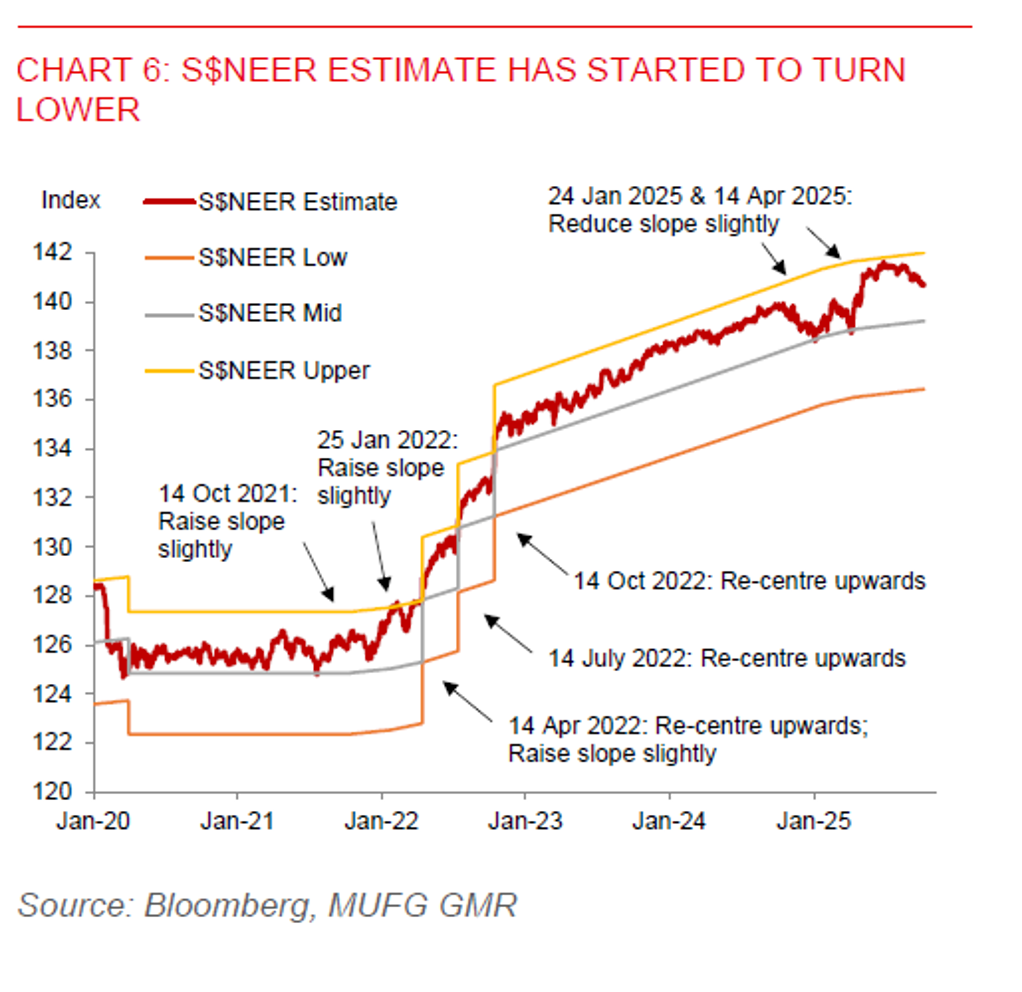Key Points
-
We expect MAS to maintain its monetary policy stance at the October meeting, keeping the policy parameters of S$NEER unchanged, while signalling that it is ready to respond if growth conditions weaken sharply.
-
MAS kept the policy steady in July, but since then Singapore’s inflation has slowed further and export momentum appears to be moderating. Despite these signs of moderation, recent communications from policymakers suggest a reactive posture rather than a pre-emptive one. The central bank appears to be waiting for more definitive evidence of economic deterioration before making another move. Moreover, the MAS has eased policy in January and April, so there is a sense that some policy accommodation has already been delivered.
-
For now, Singapore’s economy is likely to slow in Q3 following the robust 1.4%qoq pace of growth in Q2, but still showing resilience. Economic data are not yet pointing to recessionary conditions, despite the higher US reciprocal tariff coming into effect for Singapore’s trading partners. The average level of industrial production in July and August was 3.2% higher than in Q2. While there are incipient signs of payback in exports in August following earlier frontloading activity, Singapore’s re-exports were still higher than the Q1 average. Non-oil domestic exports have been on the weaker side, though, mainly driven by non-electronics exports, warranting vigilance on how global trade will evolve in the coming months. The unemployment rate has also remained relatively steady at 2%. Unless Q3 GDP data reveals a sharper than expected weakness, MAS could maintain its policy stance in October.
-
The benign inflation backdrop will also allow MAS to place greater weight on adjusting to growth risks. Indeed, disinflation has been broad-based, with food, accommodation, and private transport all contributing to the decline. Government subsidies and utility rebates are helping to contain cost pressures, while a firm SGD and softer global commodity prices are keeping imported inflation in check.
-
The slowdown in Singapore’s inflation strengthens the case for policy vigilance, but it may not be enough for MAS to resume policy easing in October. Headline CPI inflation averaged 0.8%yoy in the first eight months of this year, while core inflation (excluding private transportation and accommodation) averaged 0.6%yoy. The rate of inflation remains within the MAS inflation projection of 0.5%-1.0% for this year, and the central bank has not changed its inflation outlook even after the August core inflation reading. The central bank still sees two-way risk in inflation, with upside risk stemming from geopolitical shocks lifting commodity prices and downside risks from weaker than expected domestic economic growth.
-
President Trump’s announcement of 100% tariffs on pharmaceutical imports poses a risk. Pharmaceutical exports made up over 11% of Singapore’s non-oil domestic exports and about 2.8% of GDP in 2024. However, the immediate impact on Singapore’s economy may be cushioned, as many major pharmaceutical companies with Singapore operations have US facilities or are building capacity in the US, so they may qualify for tariff exemptions. Details are scant for now. The Singapore government has been discussing about semiconductor exports with US counterparts, while discussions regarding pharmaceutical exports may not have started yet.
-
Our estimate of the S$NEER has weakened since mid-August, but it remains roughly 1% above the midpoint of MAS’s FX policy band, keeping the SGD relatively firm. With the Fed expected to continue cutting rates and the USD likely to soften, USDSGD still has room to drift lower. However, any upside for the SGD may be modest given persistent trade headwinds. With SGD increasingly attractive as a funding currency, USDSGD volatility remaining low relative to history, and domestic inflation likely staying subdued, there appears to be a strategic opportunity to hedge against potential SGD weakness resulting from trade related risks.
-
The 3-month Singapore Overnight Rate Average (SORA) has fallen to 1.4571% by end-Q3, down from 2.0607% in end-Q2 and broadly in line with our forecast of 1.44%. SORA will likely stay subdued, given our anticipation for the Fed to continue with rate cuts in Q4, ample onshore liquidity conditions to sustain, and domestic inflation to remain subdued. We maintain our forecast for 3-month compounded SORA to fall further to 1.37% by end-year, from 1.43% currently.

